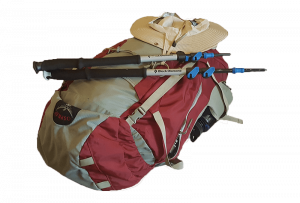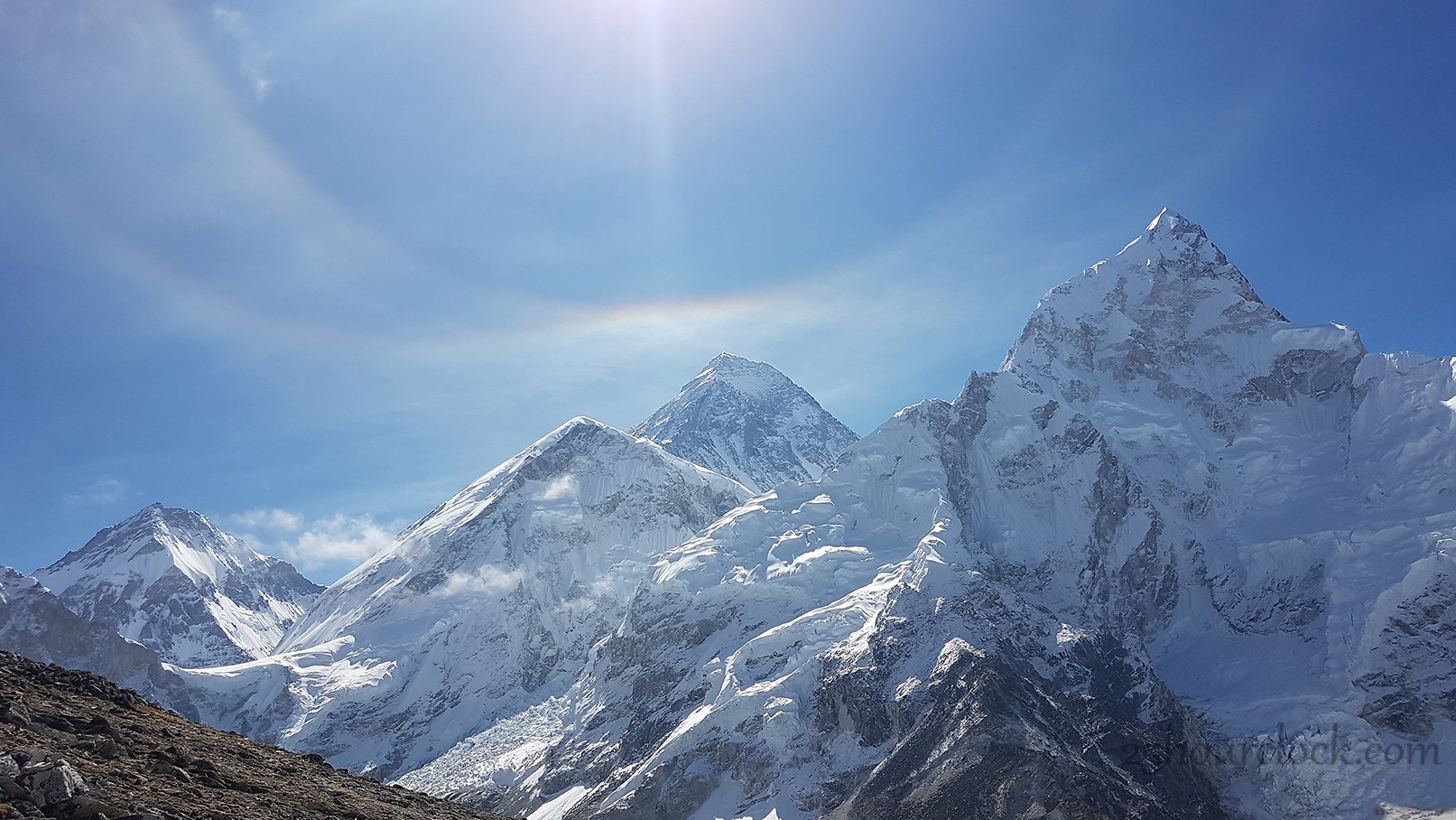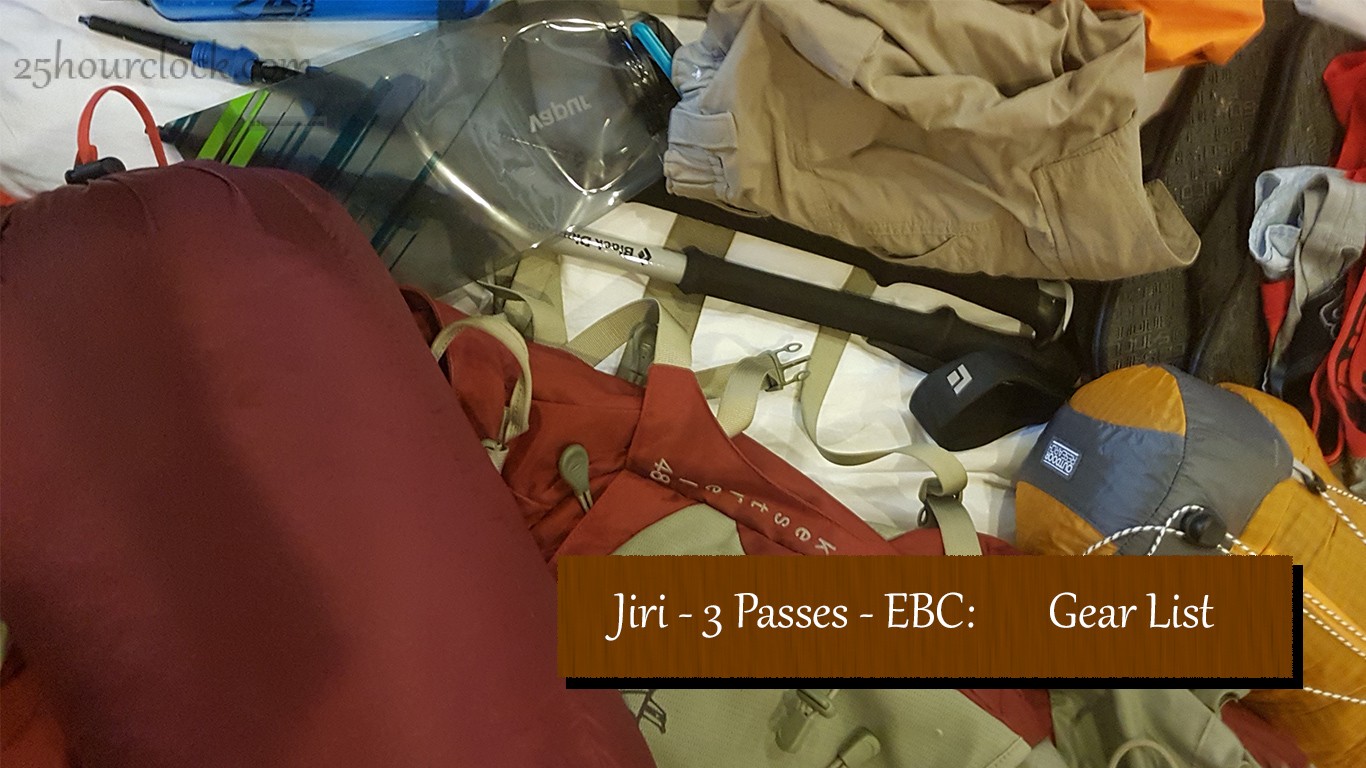 This Everest Base Camp (EBC) trek gear list is a complete list of the gear I successfully completed the journey from Jiri over the Three Passes and stopping at Everest Base Camp.
This Everest Base Camp (EBC) trek gear list is a complete list of the gear I successfully completed the journey from Jiri over the Three Passes and stopping at Everest Base Camp.
My trek was made in May during the height of the Everest climbing season. It is also a warm and reasonably dry time of the year.
The Three Passes and Everest Base camp trek is not a trek to disrespect, but in the end, it’s just hiking, don’t overthink it. You are not back country hiking, you will never be more than a couple hours from help, and never more than a day from a place to buy gear you decide you need.
See Itinerary / Tips / Info on EBC Trek.
Read Full Trip Report from an experienced trekker who accomplished the Three Passes / EBC Trek from Jiri in 20 days. Or read whole blog starting in Kathmandu.
Items – Go Light!
Mandatory
-
- Backpack: Osprey Kestrel 48
- Trekking poles: Black Diamond Expedition III – Sturdy poles that can double as ski poles and Alpine climbing poles.
- Sunglasses: I used cheap ones bought in Kathmandu.
Investing in glacier glasses is a good option.
- Water bottles: One Nalgene
one collapsible
- Steripen:
Generally, you’ll be getting water from lodges and hitting it with this
- Large plastic bag: 1 for lining your backpack, 1 for dirty stuff
- Small plastic bags: To protect valuables from moisture
- Essentials: First Aid kit – Sunscreen (30 is fine for most people) – Chapstick (apply regularly) – Ibuprofen – Imodium
- Compression stuff bags (1 for sleeping bag, 2 or 3 for clothes)
- Ball cap or Safari Cap
- Baby wipes
- Handkerchief
- Toothbrush / Toothpaste
- Deodorant
- Headlamp:
Useful for lodges and early starts.
- Backpack: Osprey Kestrel 48
Your Choice
-
- Sleeping bag. REI Igneo 17 The lighter the better. Lodges have extra blankets so any less than 20 degrees F is overkill. Reminder: This gear list is for a May trek. Other months will make a sleeping bag far more desirable.
- Sleeping bag liner – If you decide to trek sans sleeping bag, I high recommend a liner. Some lodges don’t clean their blankets as they expect them to be used on top of sleeping bags.
- Camp soap
- Travel eye cover + ear plugs
- 1-2 Toilet paper
- Power converter – pick up in Kathmandu
- Diamox – The science seems fuzzy on Diamox. It’s a diuretic, so I preferred to not take it. Once you have altitude sickness, you never know if it’s the Diamox or the time that made you better. If you decide to take it, begin taking it before Namche. Pick up in Kathmandu for $1.
Optional
-
-
- Water reserve
- Camp towel
- Foldable Bluetooth keyboard:
An incredible time saver for me
- Snacks: Rarely in a place without an eager lodge owner to sell you food
- Insect Repellent: I brought and never used, personal choice.
-
Clothing – Leave Home the Cotton
Sweat, snow, and cotton don’t mix well. Wear synthetics and wool. These are the items I brought, but this list should only be used as a guide. If you are making the trek in December, the heavier clothes will be more important, and if in May like my trek, the heavy coat can be left at home.
The trek from Jiri to Namche and the trek above Namche will be in two different conditions and requiring different sets of clothing. Nepal is about the latitude of Florida and receives a good amount of moisture from the Indian ocean so below 10,000 expect tropical conditions – hot and sticky. Above Namche, the mountains reduce some of the moisture and the air gets cooler.
Warm gear
-
- Convertible trekking pants + spare trekking pants
- Web Belt – you’ll need this, your pants won’t fit by the time you get to EBC
- 2 -3 Synthetic sport shirts:
Polyester with netted back
- 2-4 light trekking socks:
I’m a huge fan of Wigwam socks.
- 5 synthetic or wool undies
- Light trekking gloves
Cold gear
-
- Light synthetic jacket or puffy jacket: Good options in Kathmandu
- 1 or 2 Fleece top:
For cold trek days and lodges.
- 2 Synthetic or Merino wool long underwear, top & bottom
- 1 medium trekking socks
- 2 Heavy socks: mainly for lodges
- Sherpa hat or Beanie: Just buy for $4 in Kathmandu, everyone wears them
- Comfortable hiking gloves
- Glove liners
- Waterproof trekking gloves: Buy knockoffs in Namche
- Face mask and/or neck scarf
- Comfy night/lodge clothes (cotton ok)
- Optional: Heavy down coat Can rent in Namche for $1/day
- Optional: gaiters
Rain gear
-
- Rain jacket: Marmot Precip
Suited me well on rainy days below Namche and snowy days above
- Rain or Tech pants: Marmot Precip
- Rain jacket: Marmot Precip
Shoes to suit most conditions
If you are an avid hiker, you probably already know what you want to wear on your feet. I wouldn’t change that just because you are going to the Himalayas. However, keep in mind you will be crossing snow fields, and unless you plan to sit out every rain shower, you will be getting your feet wet.
I wore Merrill Moab Waterproof, which I changed from my normal Merrill Moab Ventilator. They are comfortable shoes for long treks.
Whatever shoes you decide on, make sure to hike a little in them beforehand to adapt your muscles (ie break them in).
For lodges and side trips, flip-flops, sandals, crocks, or light shoes depending on your taste.
As for the Three Passes, I found my Moabs more than sufficient. I believe it more likely to encounter conditions where step cutting would be required before any kind of icy conditions. As for micro-spikes, it was weight that didn’t seem necessary. Besides, imo, if you are you crossing a pass and you don’t need crampons, you don’t need micro-spikes.
Phone Battery Solutions
There are always options for charging your electronics. I brought a large battery as I wanted to track the hike with gps and keep notes. From Jiri to Namche, I found the lodges more liberal with their electricity. In Namche, I got the battery fully charged and didn’t need to charge it again until Gokyo.
- Battery + cables:
Anker Battery
- Optional: Solar panel – Not worth the trouble and weight in my opinion as you’ll still have to carry a battery to receive the charge.
Passing time with Nepal e-books
You’ll be surprised at your downtime. Unless you are traveling with good company or are overly extroverted, you’ll need something to read. Be sure to download them to your phone before you leave!
- Into Thin Air
- The Nepali Flat – Jiri – EBC written by amateur trekker, a nice humorous read
- Left for Dead – First person look at the 1996 tragedy
- Mountain Madness – Biography of Scott Fischer, American climber who died in the 1996 tragedy
More Info
See Itinerary / Tips / Info on EBC Trek.
Read Full Trip Report from an experienced trekker who accomplished the Three Passes / EBC Trek from Jiri in 20 days.


















